Separation of Silver and Cellulosic Fibers for Recycling and Reuse of Printed Electronic Devices Components
Abstract
1. Introduction
2. Results and Discussion
2.1. Paper-Based Printed Electronic (PE) Characterization
- The paper itself is composed of cellulose I beta and CaCO3 (calcite form), which are mainly observed. The peaks of the typical structure of cellulose I in the diffraction pattern are detected at 16° and 22°. They correspond to the (110) and (002) planes of the crystalline zone. The peaks associated with the amorphous part of cellulose are observed at 34.8°, corresponding to the (004) plane. Other compounds such as minerals, in particular CaCO3 (calcite form) were observed at 29.3°, 36°, 39.5°, 47–49°, 57–58°, and 61–62°. The analysis also highlights some very low-intensity peaks, which may be related to the presence of kaolinite-1A, traces of talc-2M, and another phase very close to talc (Mg3Si4O10(OH)2,H2O). These elements are fillers commonly used in the paper industry in the bulk and/or on the surface of the paper. The layer deposited on the surface of the paper consists essentially of a mixture of calcium carbonate and kaolin.
- Analysis of the “Paper_Silver zone” surface: the result is very similar to that of the “Paper” surface. The same peaks as described above can be observed within the diffraction pattern. In addition, silver particles can be detected clearly at 38°, 44°, 64.5°, 78°, 83°, and 98°.
- Analysis of the “Paper_Insulating_Silver” reveals an additional presence of TiO2 rutile form (27°, 41°, 54°, 57°, 63°, 69.70°, 90°, 95°). On the other hand, the traces that we had previously observed for talc and “talc hydrate” are now almost imperceptible.
2.2. Recycling Line Study
- The accepts: an aqueous suspension, rich in fibrous material with minor contamination by Ag and other minerals and substances coming from the paper substrate.
- The rejects: an aqueous suspension poor in fibrous material, where silver concentrates. This fraction also contains part of the minerals.
2.3. Characterization of the Recycled Fibers for Reuse
3. Materials and Methods
3.1. Printed Electronic Device (PE)
3.2. Chemical Reagent
3.3. Process Recycling of the Printed Electronic Device
3.4. Characterization
3.4.1. Morphological Properties
3.4.2. Structure Properties: XRD
3.4.3. Thermal Properties
3.4.4. The Schopper–Riegler Degree, WRV, and Physical Properties of Paper Sheets
3.4.5. Ash Content
3.4.6. Silver Content
- The organic matter recovery rate is defined as the amount of organic matter in the accepted fraction relative to the initial amount of organic matter introduced at the inlet of the studied operation:
- 2.
- The silver (Ag) separation rate measures the amount of silver that concentrates in the rejects, relative to the total amount of silver measured at the outlet (accept + rejects) of the studied operation:
4. Conclusions
Author Contributions
Funding
Data Availability Statement
Acknowledgments
Conflicts of Interest
References
- Radley-Gardner, O.; Beale, H.; Zimmermann, R. (Eds.) Directive 2011/7/EU of the European Parliament and of the Council. In Fundamental Texts on European Private Law; Hart Publishing: Oxford, UK, 2016. [Google Scholar] [CrossRef]
- Kavčič, U.; Kolar, M.; Žigon, M. Deinking of screen-printed electrodes printed on invasive plant-based paper. Sustainability 2020, 12, 1350. [Google Scholar] [CrossRef]
- Tabelin, C.B.; Park, I.; Phengsaart, T.; Jeon, S.; Villacorte-Tabelin, M.; Alonzo, D.; Ramos, R.; Yu, J. Copper and critical metals production from porphyry ores and E-wastes: A review of resource availability, processing/recycling challenges, socio-environmental aspects, and sustainability issues. Resour. Conserv. Recycl. 2021, 170, 105610. [Google Scholar] [CrossRef]
- Nassajfar, M.N.; Zakeri, B.; Sahebkar, A.; Ashrafi, M.; Mousavi, S.M.; Housaindokht, M.R. Alternative materials for printed circuit board production: An environmental perspective. Sustainability 2021, 13, 12126. [Google Scholar] [CrossRef]
- Kamyshny, A.; Magdassi, S. Conductive nanomaterials for printed electronics. Small 2014, 10, 3515–3535. [Google Scholar] [CrossRef]
- Barras, R.; Heitz, J.; Saiter, A.; Boukherroub, R. Printable cellulose-based electroconductive composites for sensing elements in paper electronics. Flex. Print. Electron. 2017, 2, 014006. [Google Scholar] [CrossRef]
- Hakola, L.; Hermansson, U.; Bäckström, M. Sustainable roll-to-roll manufactured multi-layer smart label. Int. J. Adv. Manuf. Technol. 2021, 117, 2921–2934. [Google Scholar] [CrossRef]
- Roselli, L.; Sardini, E.; Serpelloni, M.; Ceriotti, M. Review of the present technologies concurrently contributing to the implementation of the Internet of Things (IoT) paradigm: RFID, green electronics, WPT and energy harvesting. In Proceedings of the 2015 IEEE Topical Conference on Wireless Sensors and Sensor Networks (WiSNet), San Diego, CA, USA, 25–28 January 2015; pp. 1–3. [Google Scholar]
- Hui, Z.; Ma, J.; Xu, B. Green flexible electronics: Natural materials, fabrication, and applications. Adv. Mater. 2023, 35, 2211202. [Google Scholar] [CrossRef]
- Mir, S.; Dhawan, N. A comprehensive review on the recycling of discarded printed circuit boards for resource recovery. Resour. Conserv. Recycl. 2022, 178, 106027. [Google Scholar] [CrossRef]
- Murthy, V.; Ramakrishna, S. A review on global e-waste management: Urban mining towards a sustainable future and circular economy. Sustainability 2022, 14, 647. [Google Scholar] [CrossRef]
- Schmidt, C.W. e-Junk explosion. Environ. Health Perspect. 2002, 110, 188–194. [Google Scholar] [CrossRef]
- Yang, W.; Lu, Y.; Zhao, J.; Li, H.; Zhang, Y. Design, fabrication and applications of flexible RFID antennas based on printed electronic materials and technologies. J. Mater. Chem. C 2023, 11, 406–425. [Google Scholar] [CrossRef]
- Déprès, G.; Chevremont, A.; Schaubroeck, T.; Ragaert, K. Recycling of paper electronics in standard paper and board recycling lines. IEEE J. Flex. Electron. 2023, 2, 18–24. [Google Scholar] [CrossRef]
- Nandy, S.; Mohanty, A.K.; Nayak, S.K. Cellulose: A contribution for the zero e-waste challenge. Adv. Mater. Technol. 2021, 6, 2000994. [Google Scholar] [CrossRef]
- Sudheshwar, A.; Malinverno, N.; Hischier, R.; Nowack, B.; Som, C. The need for design-for-recycling of paper-based printed electronics—A prospective comparison with printed circuit boards. Resour. Conserv. Recycl. 2023, 189, 106757. [Google Scholar] [CrossRef]
- Zareeipolgardani, B.; Piednoir, A.; Joyard-Pitiot, B.; Depres, G.; Charlet, L.; Colombani, J. Multiscale investigation of the fate of silver during printed paper electronics recycling. Composite 2022, 1, 671–684. [Google Scholar] [CrossRef]
- Hoeng, F.; Denneulin, A.; Bras, J. Use of nanocellulose in printed electronics: A review. Nanoscale 2016, 8, 13131–13154. [Google Scholar] [CrossRef] [PubMed]
- Jansson, E.; Isotalo, T.; Tuukkanen, S. Suitability of paper-based substrates for printed electronics. Materials 2022, 15, 957. [Google Scholar] [CrossRef] [PubMed]
- Tobjörk, D.; Österbacka, R. Paper electronics. Adv. Mater. 2011, 23, 1935–1961. [Google Scholar] [CrossRef]
- Conceição, J.H.F.; Party, M.; Curtil, D.; Svecova, L.; Marlin, N.; Reverdy-Bruas, N. Investigation of methods to quantify silver screen-printed onto cellulosic substrate: Towards recycling of printed electronics. Flex. Print. Electron. 2023, 8, 035014. [Google Scholar] [CrossRef]
- Subramanian, V.; Kim, B.; Volkman, S.K.; Huang, Y.-Y.; Lee, J.; Poon, S.; Murukeshan, V.M.; Chu, W.-S.; Yu, X.; Sarma, S.; et al. Progress toward development of all-printed RFID tags: Materials, processes, and devices. Proc. IEEE 2005, 93, 1330–1338. [Google Scholar] [CrossRef]
- Aliaga, C.; Scharfe, M.; Langlois, F.; Brouzes, E. The influence of printed electronics on the recyclability of paper: A case study for smart envelopes in courier and postal services. Waste Manag. 2015, 38, 41–48. [Google Scholar] [CrossRef]
- Wu, W. Inorganic nanomaterials for printed electronics: A review. Nanoscale 2017, 9, 7342–7372. [Google Scholar] [CrossRef] [PubMed]
- Wiklund, J.; Österbacka, R.; Virkki, J.; Wågberg, L. A review on printed electronics: Fabrication methods, inks, substrates, applications and environmental impacts. J. Manuf. Mater. Process. 2021, 5, 89. [Google Scholar] [CrossRef]
- Xu, J.; Peng, C.; Jiang, Z.; Chen, Y.; Yang, J. Printable and recyclable conductive ink based on a liquid metal with excellent surface wettability for flexible electronics. ACS Appl. Mater. Interfaces 2021, 13, 7443–7452. [Google Scholar] [CrossRef] [PubMed]
- Mishra, G.; Jha, R.; Dhanunjaya Rao, M.; Meshram, A.; Singh, K.K. Recovery of silver from waste printed circuit boards (WPCBs) through hydrometallurgical route: A review. Environ. Chall. 2021, 4, 100073. [Google Scholar] [CrossRef]
- Khrustalev, D.; Tirzhanov, A.; Khrustaleva, A.; Mustafin, M.; Fedorov, F.; Anisimov, A.; Melnikov, G. A new approach to designing easily recyclable printed circuit boards. Sci. Rep. 2022, 12, 22199. [Google Scholar] [CrossRef]
- Xia, J.; Ghahreman, A. Sustainable technologies for the recycling and upcycling of precious metals from e-waste. Sci. Total Environ. 2024, 916, 170154. [Google Scholar] [CrossRef]
- Erkmen, A.N.; Ulber, R.; Jüstel, T.; Altendorfner, M. Towards sustainable recycling of critical metals from e-waste: Bioleaching and phytomining. Resour. Conserv. Recycl. 2025, 215, 108057. [Google Scholar] [CrossRef]
- Mohamed, D.; Fayad, R. The role of e-waste in sustainable mineral resource management. J. Waste Manag. 2025, 3, 27. [Google Scholar] [CrossRef]
- ISO 534:2011; Paper and Board—Determination of Thickness, Density and Specific Volume. International Organization for Standardization: Geneva, Switzerland, 2011.
- ISO 536:2019; Paper and Board—Determination of Grammage. International Organization for Standardization: Geneva, Switzerland, 2019.
- ISO 2758:2014; Paper—Determination of Bursting Strength. International Organization for Standardization: Geneva, Switzerland, 2014.
- NF Q03-011:1992; Paper—Determination of Tearing Resistance (Elmendorf Method). Association Française de Normalisation (AFNOR): Paris, France, 1992.
- NF T12-030:1994; Paper, Board and Pulps—Measurement of Diffuse Blue Reflectance Factor (ISO Brightness). Association Française de Normalisation (AFNOR): Paris, France, 1994.
- ISO 5267-1:1999; Pulps—Determination of Drainability—Part 1: Schopper-Riegler Method. International Organization for Standardization: Geneva, Switzerland, 1999.
- Silvy, J.; Romatier, G.; Chiodi, R. Méthodes pratiques de contrôle du raffinage. Revue ATIP 1968, 22, 31–53. [Google Scholar]
- Upola, H. Disintegration of Packaging Material: An Experimental Study of Approaches to Lower Energy Consumption. Available online: https://urn.fi/URN:ISBN:9789526214788 (accessed on 14 September 2024).
- Marlin, N.; Carre, B. Chapter 4: Recycled fibres. In Lignocellulosic Fibres and Wood Handbook: Renewable Materials for Today’s Environment; Belgacem, N., Pizzi, A., Eds.; Wiley-Scrivener: Hoboken, NJ, USA, 2016. [Google Scholar]
- Vilaseca, F.; Méndez, J.A.; Espinach, F.X.; Pelach, M.A.; Mutjé, P. Study and modeling of the disintegration kinetics of coated paper. BioResources 2011, 6, 1659–1669. [Google Scholar] [CrossRef]
- Statie, E.; Tanguy, P.A.; Begin, B.; Paris, J. A computational study of particle separation in hydrocyclones. J. Pulp Pap. Sci. 2002, 3, 28. [Google Scholar]
- Chaiarrekij, S.; Jiraratananon, R.; Intaravanne, Y. Deinking of recycled pulps using column flotation: Energy and environmental benefits. Resour. Conserv. Recycl. 2000, 28, 219–226. [Google Scholar] [CrossRef]
- Husovska, V. Investigation of Recycled Paper Deinking Mechanisms. Master’s Thesis, Western Michigan University, Kalamazoo, MI, USA, 2013. [Google Scholar]
- Kemper, M. State-of-the-art and new technologies in flotation deinking. Int. J. Miner. Process. 1999, 56, 317–333. [Google Scholar] [CrossRef]
- Zheng, Y.; He, Z.Z.; Gao, Y.; Liu, J. Direct desktop printed-circuits-on-paper flexible electronics. Sci. Rep. 2013, 3, 1786. [Google Scholar] [CrossRef]
- Hubbe, M.A.; Venditti, R.A.; Rojas, O.J. What happens to cellulosic fibers during papermaking and recycling? BioResources 2007, 2, 739–788. [Google Scholar] [CrossRef]
- ISO 5269-2:2004; Pulps—Preparation of Laboratory Sheets for Physical Testing—Part 2: Rapid-Köthen Method. International Organization for Standardization: Geneva, Switzerland, 2004.
- ISO 187:2022; Paper, Board and Pulps—Standard Atmosphere for Conditioning and Testing and Procedure for Monitoring the Atmosphere and Conditioning of Samples. International Organization for Standardization: Geneva, Switzerland, 2022.
- NF Q 03-002; Paper and Board—Determination of Tensile Properties—Part 2: Constant Rate of Elongation Method (20 mm/min). Association Francaise de Normalisation: Paris, France, 2009.
- NF Q 03-053; Paper and Board Testing—Determination of Burst Strength (Strength Between 70 kPa and 1300 kPa). Association Francaise de Normalisation: Paris, France, 1983.
- TAPPI T 452 OM-23; Brightness of Pulp, Paper, and Paperboard (Directional Reflectance at 457 nm). Technical Association of the Pulp and Paper Industry (TAPPI): Peachtree Corners, GA, USA, 2023.
- TAPPI T 211 OM-07; Sampling and Preparing Handsheets for Physical Tests. Technical Association of the Pulp and Paper Industry (TAPPI): Peachtree Corners, GA, USA, 2007.

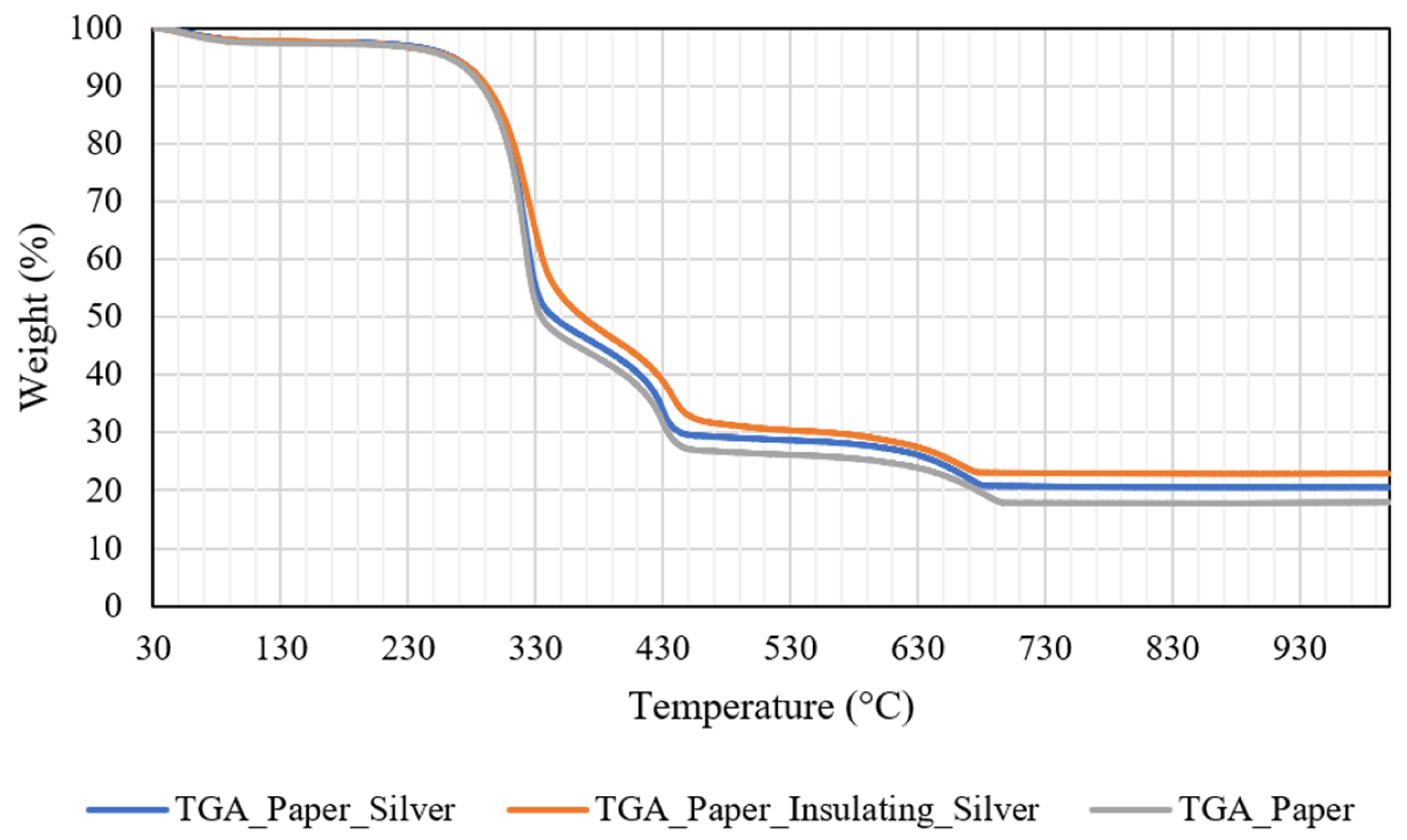
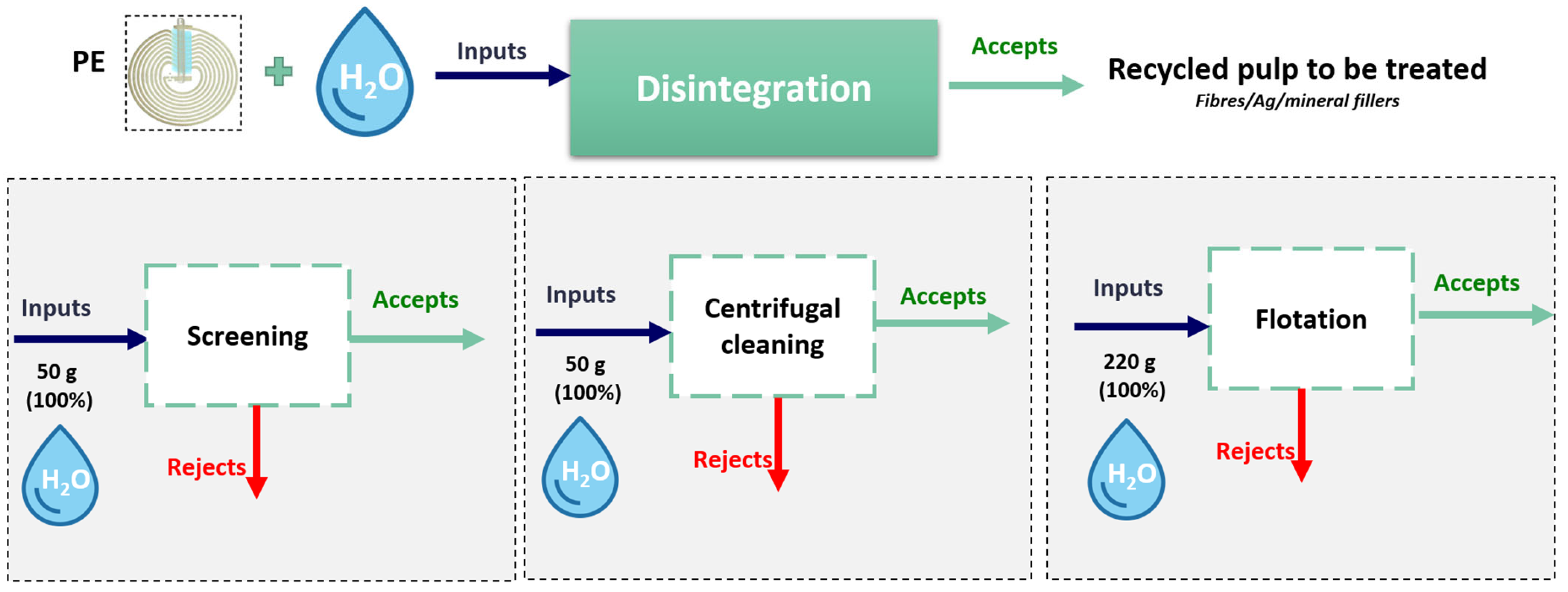
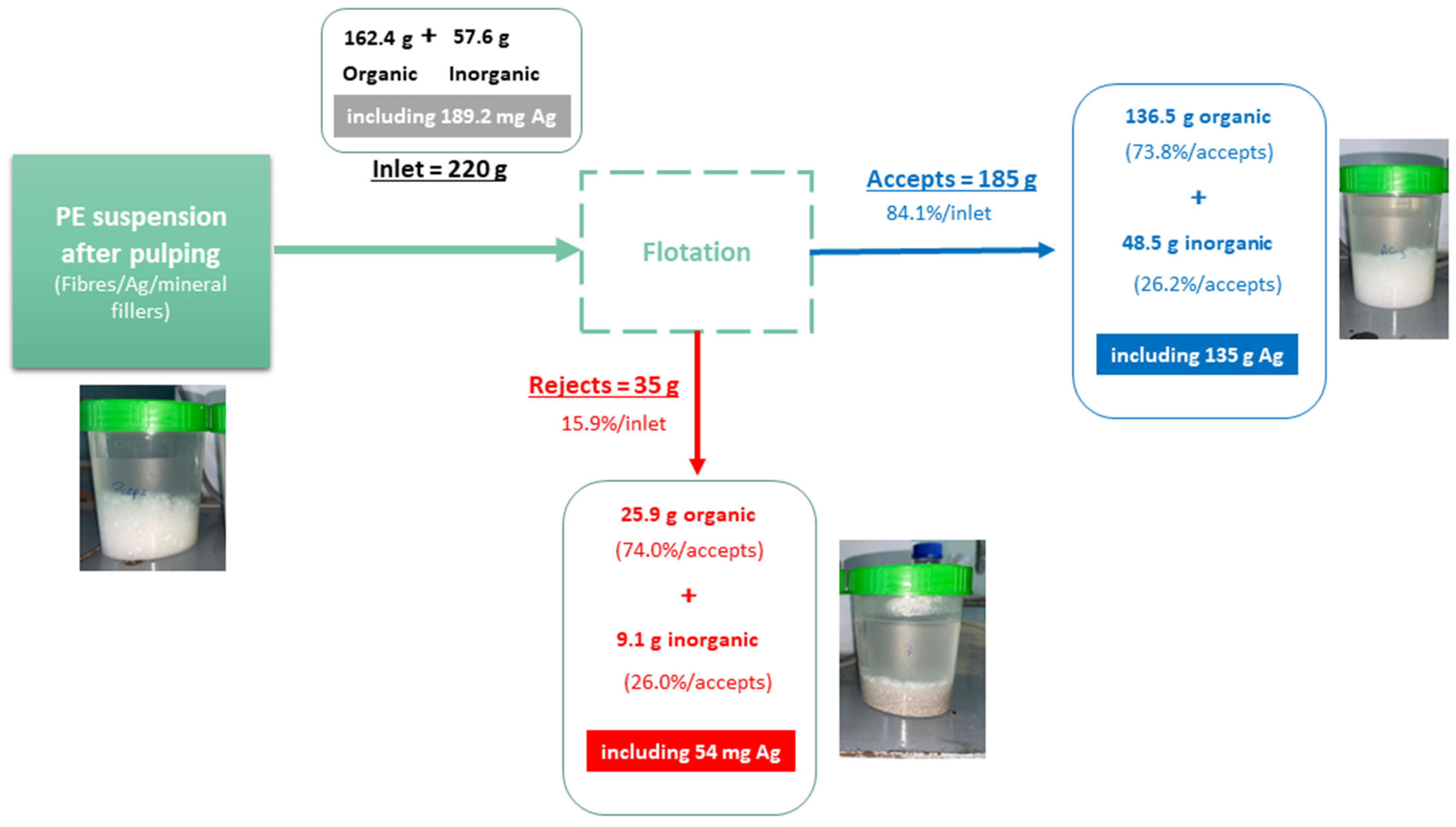

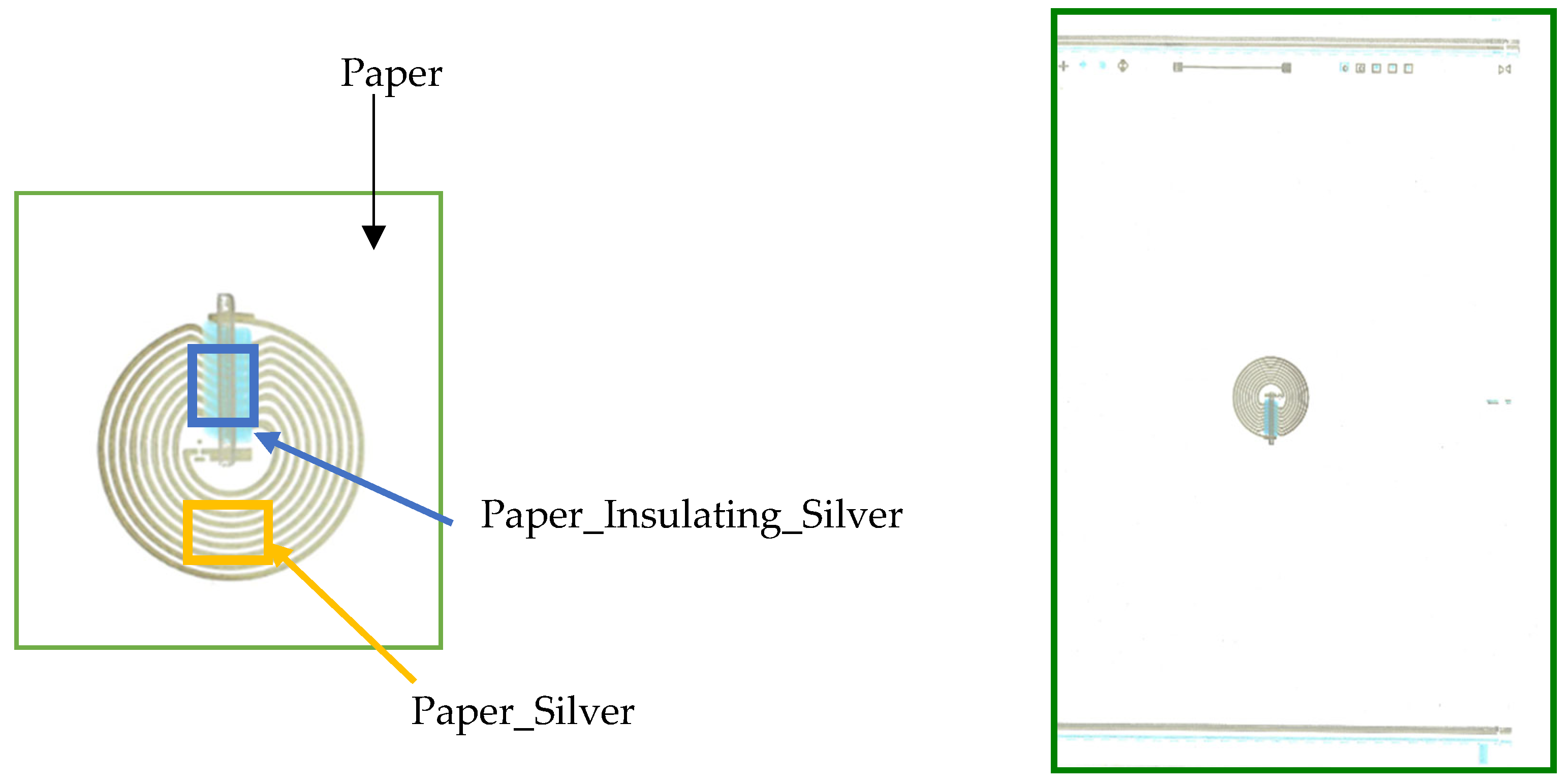
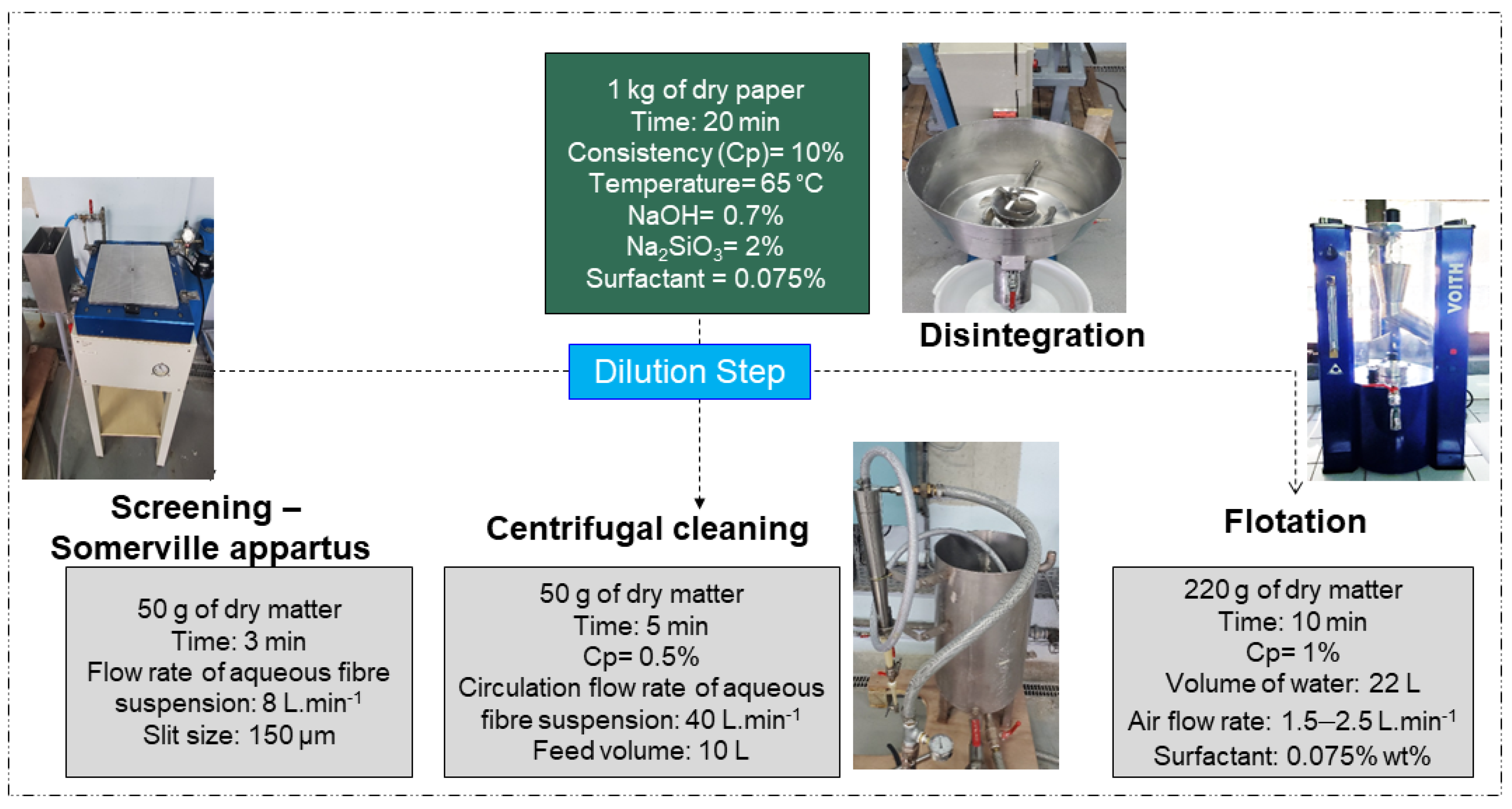
| Handsheets | Standard Methods | Reference | |
|---|---|---|---|
| Thickness (µm) | 117 ± 6 | ISO-534 | [32] |
| Basis weight (g·m−2) | 77 ± 4 | ISO-536 | [33] |
| Bulk (cm3·g−1) | 1.50 | ISO-534 | [32] |
| Burst index (kPa·g−1) | 2.60 ± 0.30 | ISO 2758 | [34] |
| Tear index (mN·m2·g−1) | 1.90 ± 0.40 | NFQ03-011 | [35] |
| Sheet formation index | 56.30 ± 0.04 | - | - |
| Brightness (457 nm) | 80.80 ± 0.10 | NFT.12.030 | [36] |
| Shopper Riegler degree (°SR) | 28 | ISO 5267 | [37] |
| WRV (%) | 81.7 ±1.3 | - | [38] |
| Paper | Paper_Insulating_Silver | Paper_Silver | |
|---|---|---|---|
| Water content (%) (measured at T = 150 °C) | 2.7 | 2.5 | 2.5 |
| Ash content (%) (measured at T = 525 °C) | 26.2 | 30.4 | 28.7 |
| Organic matter content (%) | 73.8 | 67.1 | 68.8 |
| Organic Fraction (g) | Inorganic Fraction (g) | Ag (mg) | |
|---|---|---|---|
| Screening (50 g input) | 36.9 | 13.1 | 43 |
| Flotation (220 g input) | 162.4 | 57.6 | 189.2 |
| Centrifugal Cleaning (50 g input) | 36.9 | 13.1 | 43 |
| Handsheets | Standard Methods | Reference | |
|---|---|---|---|
| Thickness (µm) | 118 ± 3 | ISO-534 | [32] |
| Basis weight (g·m−2) | 78 ± 2 | ISO-536 | [33] |
| Bulk (cm3·g−1) | 1.5 | ISO-534 | [32] |
| Burst index (kPa·g−1) | 2.8 ± 0.2 | ISO 2758 | [34] |
| Tear index ((mN.m2·g−1) | 1.7 ± 0.8 | NFQ03-011 | [35] |
| Sheet formation index | 54.3 ± 0.1 | - | |
| Brightness (457 nm) | 79.4 ± 0.4 | NFT.12.030 | [36] |
Disclaimer/Publisher’s Note: The statements, opinions and data contained in all publications are solely those of the individual author(s) and contributor(s) and not of MDPI and/or the editor(s). MDPI and/or the editor(s) disclaim responsibility for any injury to people or property resulting from any ideas, methods, instructions or products referred to in the content. |
© 2025 by the authors. Licensee MDPI, Basel, Switzerland. This article is an open access article distributed under the terms and conditions of the Creative Commons Attribution (CC BY) license (https://creativecommons.org/licenses/by/4.0/).
Share and Cite
Khiari, R.; Marlin, N.; Curtil, D.; Aurousseau, M.; Svecová, L.; Reverdy-Bruas, N. Separation of Silver and Cellulosic Fibers for Recycling and Reuse of Printed Electronic Devices Components. Recycling 2025, 10, 201. https://doi.org/10.3390/recycling10060201
Khiari R, Marlin N, Curtil D, Aurousseau M, Svecová L, Reverdy-Bruas N. Separation of Silver and Cellulosic Fibers for Recycling and Reuse of Printed Electronic Devices Components. Recycling. 2025; 10(6):201. https://doi.org/10.3390/recycling10060201
Chicago/Turabian StyleKhiari, Ramzi, Nathalie Marlin, Denis Curtil, Marc Aurousseau, Lenka Svecová, and Nadège Reverdy-Bruas. 2025. "Separation of Silver and Cellulosic Fibers for Recycling and Reuse of Printed Electronic Devices Components" Recycling 10, no. 6: 201. https://doi.org/10.3390/recycling10060201
APA StyleKhiari, R., Marlin, N., Curtil, D., Aurousseau, M., Svecová, L., & Reverdy-Bruas, N. (2025). Separation of Silver and Cellulosic Fibers for Recycling and Reuse of Printed Electronic Devices Components. Recycling, 10(6), 201. https://doi.org/10.3390/recycling10060201









